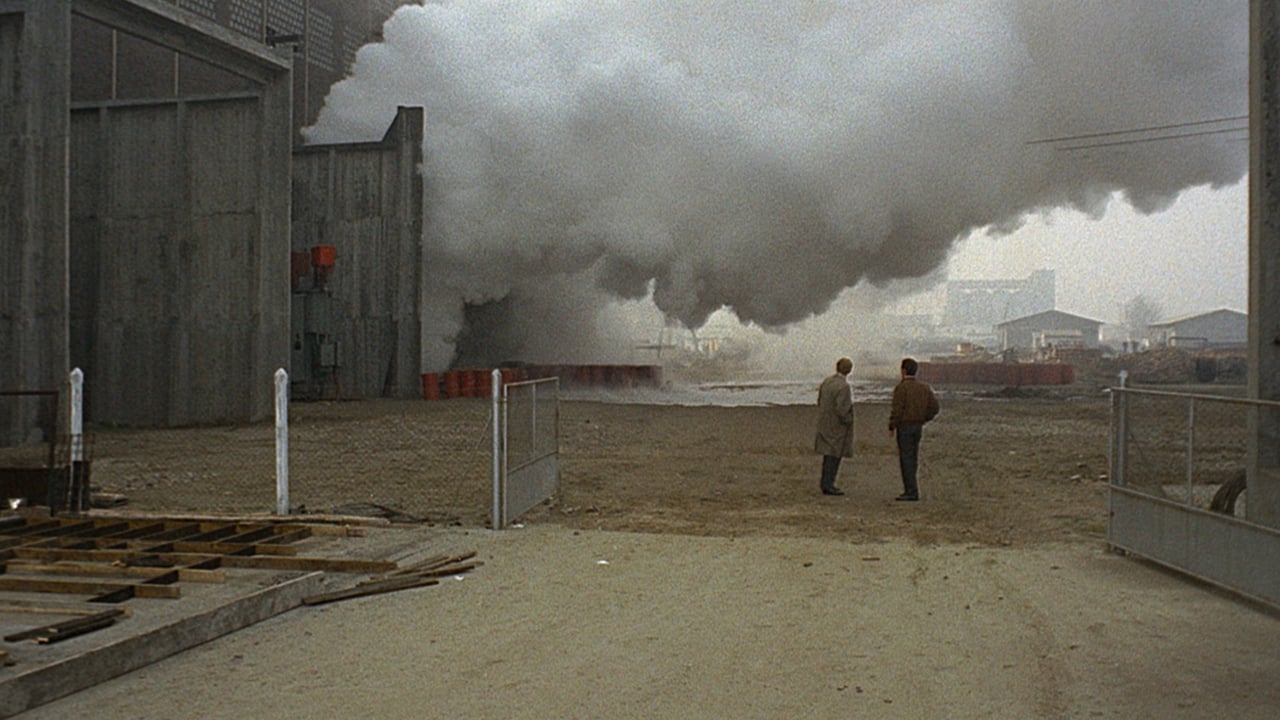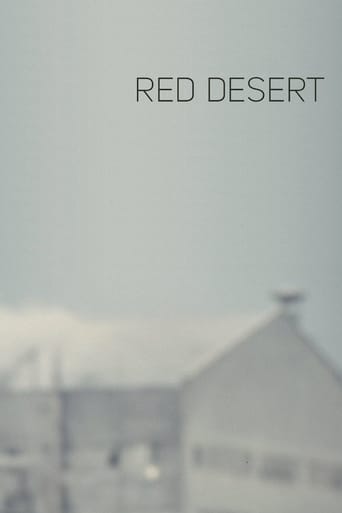

That was an excellent one.
... View MoreReally Surprised!
... View MoreThis film is so real. It treats its characters with so much care and sensitivity.
... View MoreIt's a good bad... and worth a popcorn matinée. While it's easy to lament what could have been...
... View MoreAnother film with the "Antonioni brand". Little (apparently) happens, slow pace, long scenes without any dialogues (Brian De Palma saw for sure Antonioni's films ...), some things (seemingly) pointless, improved and obsessive technique in sound and image. As for us, those of us who have an open mind and who truly enjoy the art of cinema, we simply love and are dazzled by what we see. Excellent performance by Monica Vitti.
... View MoreYup, it's another Antonioni. Should have learned my lesson after Zabriskie Point but I guess I keep expecting a color-filled Blow Up. I'd go to 3-4 stars for this film with just Monica Vitti walking around jarring industrial landscapes. Carlo Di Palma does a great job filming, but only when outdoors, and more than about 4 feet away. Closeups and small interiors feel TV like, and horribly stifled. Several times I felt we were half a step from a telenovela. But mostly, I didn't even care what they said. The story is lacking, or stupid, or poorly done, or pointless. I don't care about anyone in the film, at all. I so don't care about the story I find it hard to evaluate it. Oh, and Richard Harris is a native of Trieste? Why? What is this silliness? Not a thing he did from talking about how out of place he is in the world to kicking straw in the yard felt remotely real.
... View More"There's something terrible in reality," Guiliana (Monica Viti) tells Corrado Zeller (Richard Harris) towards the end of the film. This statement encapsulates Viti's character perfectly. Guiliana is withdrawn, has bouts of anxiety and paranoia. She had previously been in a car accident involving a van and been hospitalised for a year with serious shock. This role is played beautifully by Viti (who had collaborated with Antonioni on his three previous films); whilst she strikes the occasional contorted pose, she uses her eyes majestically to portray a fractured, anxious thought process. If her eyes are not frantically darting around, encapsulating immaculate confusion, then they are sunken, glacial, and permeated with sadness.Guiliana is married, but on meeting her, Corrado seems almost infatuated with her awkward, unstable demeanour. They enter into a subdued affair that is restrained by her seemingly perpetual elusiveness. She is haunted by details - that we have no awareness - of the road accident. It could also be argued that Guiliana is affected by the surroundings she inhabits. The film is set in Ravenna, an industrialised, bleak landscape of factories; chimneys pumping out fumes, infecting the horizon with a dense fog. All that is left of the natural surroundings of field and trees, is the bare-bones of rotten, forgotten husks. The once-green grass churned into slurry. The infected waters, yellow and frothing as the waves hit the poisonous rocks.This was Michelangelo Antonioni's first film in colour. The last in a loose tetralogy informed with themes of alienation in the modern, industrialised world. Red Desert was preceded by L'Avventura (1960), La Notte (1961) and L'eclisse (1962). Whilst much of the landscape filmed here, the overall effect of the visuals is astonishingly beautiful. These stark, brooding images stay with you. Whilst the natural colours (dissipated by the onslaught of industrial waste infecting the air) are washed out by heavy pollution, Antonioni lightly daubs his mise-en-scene with slight painterly strokes of colour (often out-of-focus) across the composition with a mass-produced object of manufactured descent.The theme of the relationship between the polluting element of the manufacturing industry with human emotion is open to interpretation in this film. Do we see these objects of consumerist desires that illuminate the screen with their intensely garish, gauche, fabricated colours, as the fundamental fascination with the industrial age? Are we, like Guiliana, so totally absorbed by our modernist surroundings that we find solace in the objects that this modern industrial age has produced? Any film that is open to new ideas excites me. A film that can be represented with new adaptation of thought. Our understanding of technology, and the changing face of industrialisation/globalisation will undoubtedly change, as I am sure will the interpretations of this beautifully constructed piece of cinema/art.www.the-wrath-of-blog.blogspot.com
... View MoreI love Antonioni for these flickering realities. In Blowup he gave us memory as the chimera of the mind, the formation of human suffering. Going backwards to The Red Desert, I find that the mind hasn't been transcended yet, nonetheless we get a beautiful paradigm on the acceptance of that suffering as a fundamental condition of life. This is not an ultimate reality, but at least it's a first awareness of the appearance of suffering.We have the fragile, erratic, woman with the fractured soul as main character here, learning to be whole again. Only Bergman had done this before, but Through a Glass Darkly is literary and it pales when we see it next to the power of Antonioni's cinema. People like Polanski and Lynch would go on to make similar films with varying degrees of insanity permitted by surreal devices, moving them inside the fracture, the brilliance here is how the movie hops in and out of it, swapping and shaping realities.This is true first in the marvellous embedded story the mother narrates to her little boy, we see this unfold in her mind's eye (not the boy's). The island world there is peaceful and contained, sufficient and whole unto itself. Now and then mystery beckons and the girl in the story swims out to it, but she doesn't lose heart when it eludes her. It's in the nature of things to elude us. I like how these mysteries are vaguely poetic, a saiboat and an unseen song, as opposed to the violent omens encountered in David Lynch.I discover this again in the bedroom scene where Corrado coerces a shaken Guiliana into sex, a masterstroke by Antonioni because it's an uncomfortable coupling to see, yet not vulgar or perverse. Guiliana submits to the sexual advances, and for a moment the room turns inexplicably pink, like the sand in the island of her dreams. The wonderful ambiguity of this is that it's never apparent whether the fantasy is where she flees for safety or if she permits sex in order to reach it. But that flight into imagination lasts only for a while and does not change the world, the bedroom is still the same.I love how, with hardly any consideration or concession made to how a story ought to be explained, Antonioni sketches in a bleak barren landscape that serves as projection of tormented minds the traces of human souls aching for connection, seeking a unity of bodies that soothes in the yawning nothingness of the universe. He does not wait for a god to make his presence felt or perceive the defeaning silence as proof of damnation, but rather ushers his characters on a path towards self awareness.Guiliana's torment then begins with her false perception of the world. When she hears a scream that her husband didn't, she's shaken, desperate to prove it to herself, unsure if she did hear a scream after all. Outside the cabin, the mist hides her company from her eyes and she despairs more. In the mind's fixation to a world we think should be unchanging and always grasped, the world itself begins to fade.When they finally separate, Guiliana pushing him out because now she knows he can't help her, knowing also that the courage must come from inside and that she must not cling to things or people to get through the day, Corrado leaving with hardly a word, knowing at the same time that he can't help her either, it's like a firework of cinema.The final scene, where Guiliana explains to her son about the poisonous yellow smoke and how the birds have learned not to fly there, could be saying too much about her newfound awareness because we can infer it from the scene with the Turkish sailor, but I like how Antonioni bottles the sentiment in a gentle metaphor. As humans we may be swimming alone in a sea of suffering, but we can learn to tranquil the hand that makes it navigable.The one touch I have a hard time swallowing, is that Antonioni doesn't trust us to understand who the "girl in the hospital" was, making Monica Vitti tell us. Perhaps the film is enough of a drifting haze as it is and he wanted to drop an anchor there, to make at least something certain.It's the acceptance of suffering as part of life that matters here for me, how Antonioni makes cinema with it is only the masterstroke. As with films he made later, his cinema is spiritually important to me because conceptual understanding of ideas he presents or the appreciation of the visual vocabulary, which is rich in color and texture like few directors managed, cannot substitute for the final, tangible, experience of living through it all.
... View More